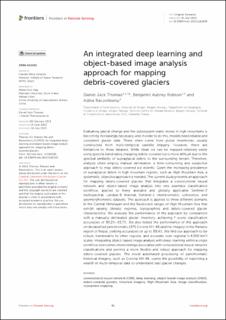| dc.description.abstract | Evaluating glacial change and the subsequent water stores in high mountains is becoming increasingly necessary, and in order to do this, models need reliable and consistent glacier data. These often come from global inventories, usually constructed from multi-temporal satellite imagery. However, there are limitations to these datasets. While clean ice can be mapped relatively easily using spectral band ratios, mapping debris-covered ice is more difficult due to the spectral similarity of supraglacial debris to the surrounding terrain. Therefore, analysts often employ manual delineation, a time-consuming and subjective approach to map debris-covered ice extents. Given the increasing prevalence of supraglacial debris in high mountain regions, such as High Mountain Asia, a systematic, objective approach is needed. The current study presents an approach for mapping debris-covered glaciers that integrates a convolutional neural network and object-based image analysis into one seamless classification workflow, applied to freely available and globally applicable Sentinel-2 multispectral, Landsat-8 thermal, Sentinel-1 interferometric coherence, and geomorphometric datasets. The approach is applied to three different domains in the Central Himalayan and the Karakoram ranges of High Mountain Asia that exhibit varying climatic regimes, topographies and debris-covered glacier characteristics. We evaluate the performance of the approach by comparison with a manually delineated glacier inventory, achieving F-score classification accuracies of 89.2%–93.7%. We also tested the performance of this approach on declassified panchromatic 1970 Corona KH-4B satellite imagery in the Manaslu region of Nepal, yielding accuracies of up to 88.4%. We find our approach to be robust, transferable to other regions, and accurate over regional (>4,000 km2) scales. Integrating object-based image analysis with deep-learning within a single workflow overcomes shortcomings associated with convolutional neural network classifications and permits a more flexible and robust approach for mapping debris-covered glaciers. The novel automated processing of panchromatic historical imagery, such as Corona KH-4B, opens the possibility of exploiting a wealth of multi-temporal data to understand past glacier changes. | en_US |

